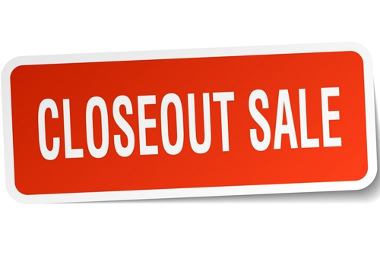Definition Of Closeouts

Closeout inventory is excess inventory that the company no longer needs or wants . This is merchandise that the company does not rely on to run its everyday business, and it is extra stock. This product is taking up valuable warehouse space and costing money in storage fees, so the inventory should be liquidated and converted to cash. There are different reasons a company may have closeout inventory and we will explore them here. Closeout sales are final and when the inventory is gone it will not be replenished.
Excess Inventory. A company might have sell slow moving inventory in the warehouse because management overbought and has more of the product in the warehouse than they can sell. The buyer may have made a mistake when ordering, or it is possible that sales did not meet expectations and they were not able to ship enough of the merchandise. In either case, the result was too much merchandise on hand. Closeouts are also often referred to as “excess inventory” or “discontinued inventory”.
Package Changes. Another reason a company may have closeout stock is from a package change. When the packaging is changed or redesigned, this often results in leftover inventory of the old package design which creates a closeout. Sometimes the best way to sell closeout inventory is to heavily discount the merchandise just to get rid of it so the company can move forward with the new packaging. It is a closeout since there is nothing wrong with the inventory; it is simply a change in the exterior packaging.
Canceled Orders. Many times closeoutsare a result of orders being canceled. As an example, let’s use the ABC Widget Company in an illustration of how a company can generate closeouts. ABC imports a full container of widgets for one of it’s best customers, a large chain of retail stores. The order was placed in good faith more than two months ago by one of the buyers who has purchased from ABC for many years. However, the past 2 months have been especially challenging for the customer, whose retail stores have had unusually slow traffic due to a downturn in the local economy. As a result, the customer cancels the container of widgets just as it arrives in the United States. ABC Distributors doesn’t want to jeopardize its relationship with the customer so they agree to cancel the order. Now what? Now ABC Distributors has an extra container of widgets they don’t want, and they have to offer it on closeout sale to get rid of it. It is much cheaper to discount the inventory and take a loss on it than have it sit in the warehouse for years. Selling excess inventory is the best way out of this situation.
Discontinued Merchandise. Part of running a business is updating the inventory and always keeping it fresh. Old merchandise doesn’t sell and it has to be cycled out for new and exciting products. But what is a company to do with the old discontinued merchandise? The best way to get rid of it is to mark down the price, have a closeout sale, and turn it into cash. Companies sell discontinued merchandise to generate cash and free up valuable warehouse space. In both cases, this is an example of selling closeouts.
In all of the above cases, closeout inventory should be disposed of and converted to cash as quickly as possible. Obsolete inventory costs the company money because it takes up valuable warehouse space that can otherwise be put to good use storing profitable inventory. Selling discontinued inventory is the most prudent thing to do because it generates cash and makes room in the warehouse. A closeout sale is a final sale is normally first come first served. Once the inventory is gone it is no longer available.



